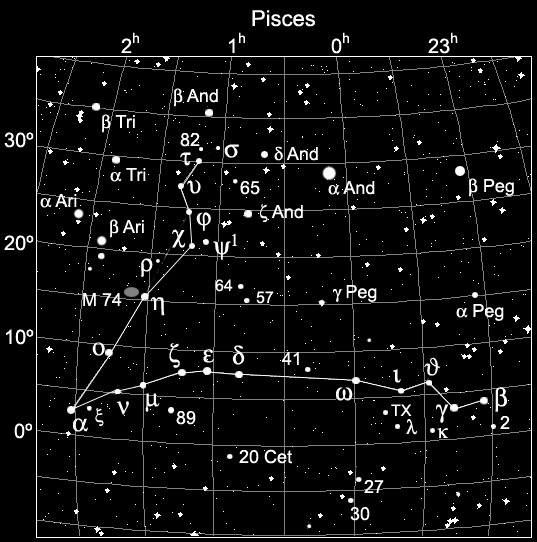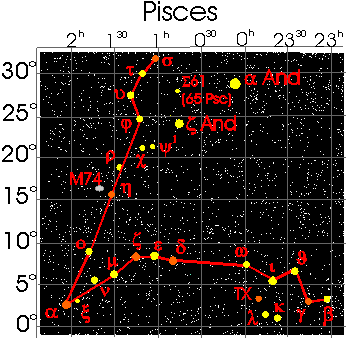
Although Pisces is an ancient constellation, it's quite faint. You'll need perfect nights to best study the constellation. The one Messier object (M74, a spiral galaxy) is much too faint for binoculars. The variable TX Psc is perhaps the most interesting object here.

Alpha Piscium (Al Rischa, The Cord) ties the two fish together. Locating Al Rischa could be a problem if you don't enjoy the best skies. It's found far to the southeast of the constellation. First find Alpheratz and Aldebaran. Draw a line from Alpheratz to Aldebaran; you'll find Hamal midway along this line. Now from Hamal drop straight south twenty degrees (three FOVs). In early Autumn skies Pisces is to the southeast around one or two a.m.; during the last week of October it is due south at midnight. Al Rischa is actually a double system, with the companion making an orbit every 933 years. The combined magnitude of both stars is only 3.8. In fact most stars in this constellation are only 4th- or 5th-magnitude. Also, to make matters a bit more difficult, the stars are widely scattered, and don't form a distinctive asterism. With the naked eye you might discern a line of stars to the northwest of alpha and another one stretching out westward. These two faint lines represent the two fish.
Delta Piscium is a 4.4 mag star roughly half-way along the western-most fish. This western-most fish terminates at either gamma or beta (both have been represented as the terminal point). From zeta move one and a half binocular fields west.
Eta Piscium is the second brightest star in Pisces with a visual magnitude of 3.8. However the combined mag of the two components of this binary system make the apparent brightness 3.6, which just beats out gamma Piscium (3.7). This yellow giant is 15º northwest of alpha and easily found with the naked eye. In the same region is the very faint spiral galaxy M74 (one of the faintest of Messier's objects). The ‘fish’ continues to the northwest, past rho and on up to sigma Piscium.
Gamma Piscium is the tip of the western fish, far to the west. It's in the same FOV as theta and iota. In fact, these stars form a giant circle, along with kappa and lambda. With the naked eye, if you've proceeded west of alpha to zeta and to delta, now continue westward the same apparent distance, you'll come to a circle. Rather than having to follow the stars of the fish out from alpha Piscium, you can also find gamma by dropping south of Markab (alpha Pegasi, the southwest corner of the Great Square) two and a half FOVs. Having found gamma, you can easily locate TX Piscium, the deep red irregular variable.
Sigma Piscium is the tip of one of the two fish represented by this constellation. This is only a 5.5 visual magnitude star, barely visible to the naked eye. It's found 15º west of alpha Andromedae and a couple of degrees to the north. Even easier is to enter Pisces from the top by dropping straight down from beta Andromedae five degrees (that is, if you put beta And at the top of your glasses, sigma Piscium is in the same FOV.
TX Piscium also goes under the Flamsteed label of 19 Piscium. This variable is a very deep red, well seen in binoculars. The star's visual magnitude varies irregularly from roughly 4.8 to about 5.6.
To find the star first locate gamma Piscium. Then move slightly to the east, with iota to the north. TX Psc will be nearly centered.
Zeta Piscium is a double for small telescopes: 5.2, 6.4, PA 63º, 23" separation. More to the point, as you make your way along this western fish, is that it is the eastern point of a distinctive arrow-shaped asterism to the west-northwest of alpha two binocular fields.
